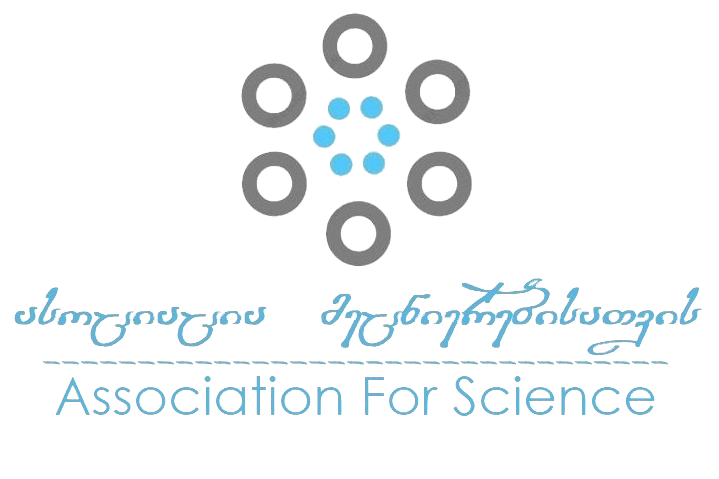ენდოგენური პეპტიდების როლი ორგანიზმების სისტემურ თვითრეგულაციაში
Keywords:
პეპტიდი, თვითრეგულაცია, სისტემური თვითრეგულაცია, პეპტიდ-ჰორმონი, ჰომეოსტაზირეზიუმე
რეგულატორული პეპტიდები - ბიოლოგიურად აქტიური ნაერთების ფართო ჯგუფია, რომელიც გავლენას ახდენს ცოცხალ ორგანიზმებში მიმდინარე ფიზიოლოგიურ პროცესებზე. პეპტიდები სინთეზირდება ყველა ბიოლოგიური სახეობის ორგანიზმში, დაწყებული ბაქტერიებით და დამთავრებული ძუძუმწოვრებით. ბიოლოგიური თვალსაზრისით, რეგულატორული პეპტიდები, მრავალმხრივ გავლენას ახდენენ ორგანიზმზე. ისინი მოქმედებენ, როგორც ნეირომედიატორები, ნეირომოდულატორები, ჰორმონები, ზრდის ფაქტორები, ციტოკინები და ა.შ. ყველა მრავალუჯრედიანი ორგანიზმისათვის აუცილებელია უჯრედის ფუნქციის მართვის რეგულატორული სისტემები, რომლებიც მათ გააერთიანებს ერთი მთლიანი ორგანიზმის საზღვრებში. მე-20 საუკუნის პირველ ნახევარში ითვლებოდა, რომ არსებობდა ასეთი სახის სამი სისტემა: ნერვული, იმუნური და ენდოკრინული. მიჩნეული იყო, რომ ეს სისტემები დამოუკიდებლად მოქმედებდნენ და მათი ურთიერთქმედება წესიდან გამონაკლისი იყო. მე-20 საუკუნის 60-იან წლებში საკმარისი სამეცნიერო მონაცემები დაგროვდა იმის შესახებ, რომ აღნიშნული სისტემების ერთობლივად მოქმედების განმსაზღვრელი ფაქტორი იყო - ბიოლოგიურად აქტიური პეპტიდები.დღესდღეობით, შესწავლილია პეპტიდების ფიზიკურ-ქიმიური თვისებები, მათი სპეციფიკური მოქმედება, შემუშავებულია ფიზიოლოგიურად აქტიური პეპტიდების სინთეზური ანალოგები, განხორციელდა რეგულატორული პეპტიდების ქიმიური სინთეზი და დადასტურდა ადამიანის ორგანიზმზე მათი თერაპიული მოქმედება. მონოგრაფიაში წარმოდგენილია ბიოლოგიურ ორგანიზმებში ენდოგენური პეპტიდების გავლენა სხვადასხვა ფიზიოლოგიურ პროცესებზე. განხილულია მათი სტრუქტურული აღნაგობა და მოქმედების მექანიზმები. გარდა ამისა, მოცემულია როგორც ბუნებრივი, ისე ხელოვნური პეპტიდების გამოყენება და გამოყენების პერსპექტივები მედიცინაში.
გადმოწერა
გამოყენებული ლიტერატურა
Baker C., Richards L.J., Dayan C.M., Jessop D.S.Corticotropin-releasing hormone immunoreactivity in human T and B cells and macrophages: colocalization with arginine vasopressin // J. Neuroendocrinol. 2003. Vol. 15. № 11. P. 1070–1074.
Bankir L., Perucca J., Weinberger M.H. Ethnic differences in urine concentration: possible relationship to blood pressure //Clin. J. Am. Soc. Nephrol. 2007. Vol. 2. № 2. P. 304–312.
Caldwell H.K., Young W.S. III Oxytocin and vasopressin:genetics and behavioral implications // Handbook of neurochemistry and molecular neurobiology neuroactive proteins and peptides / A Lajtha, R. Lim. Berlin: Springer, 2006. P. 573–607.
Chiu T., Wu S.S., Santiskulvong C. et al. Vasopressinmediated mitogenic signaling in intestinal epithelial cells // Am. J. Physiol. Cell Physiol. 2002. Vol. 282. № 3. P. C434–450.
Dheen S.T., Tay S.S., Wong W.C. Arginine vasopressin- and oxytocin-likes immunoreactive neurons in the hypothalamic paraventricular and supraoptic nuclei of streptozotocininduced diabetic rats // Arch. Histol. Cytol. 1994. Vol. 57. № 5. P. 461–472.
Enhorning S., Wang T.J., Nilsson P.M. et al. Plasma copeptin and the risk of diabetes mellitus // Circulation. 2010. Vol. 121. № 19. P. 2102–2108.
Gallo-Payet N., Guillon G. Regulation of adrenocortical function by vasopressin // Horm. Metab. Res. 1998. Vol. 30. № 6–7. P. 360–367.
Ghosh P.M., Mikhailova M., Bedolla R., Kreisberg J.I.Arginine vasopressin stimulates mesangial cell proliferation by activating the epidermal growth factor receptor // Am. J. Physiol. Renal. Physiol. 2001. Vol. 280. № 6. P. 972–979.
Havel R.J., Goldfien A. The role of the sympathetic nervous system in the metabolism of free fatty acids // J. Lipid. Res. 1959. Vol. 1. № 1. P. 102–108.
Hiroyama M., Aoyagi T., Fujiwara Y. et al. Hypermetabolism of fat in V1a vasopressin receptor knockout mice // Mol. Endocrinol. 2007. Vol. 21. № 1. P. 247–258.
Koshimizu T.A., Nakamura K., Egashira N. et al. Vasopressin V1a and V1b receptors: from molecules to physiological systems // Physiol. Rev. 2012. Vol. 92. № 4. P. 1813–1864.
Kuro-o M. Klotho // Pflugers Arch. 2010. Vol. 459. № 2.P. 333–343.
Landry D.W., Levin H.R., Gallant E.M. et al. Vasopressin deficiency contributes to the vasodilation of septic shock // Circulation. 1997. Vol. 95. № 5. P. 1122–1125.
Luttinger D., Hernandez D.E., Nemeroff C.B., Prange A.J. Jr. Peptides and nociception // Int. Rev. Neurobiol. 1984. Vol. 25. P. 185–241.
Mavani G.P., DeVita M.V., Michelis M.F. A review of the nonpressor and nonantidiuretic actions of the hormone vasopressin // Front. Med. (Lausanne). 2015. Vol. 2.ID 19.
Ohnishi M., Razzaque M.S. Dietary and genetic evidence for phosphate toxicity accelerating mammalian aging //FASEB J. 2010. Vol. 24. № 9. P. 3562–3571.
Park S.J., Shin J.I. Inflammation and hyponatremia: an underrecognized condition? // Korean J. Pediatr. 2013. Vol. 56. № 12. P. 519–522.
Pasquali R., Gagliardi L., Vicennati V. et al. ACTH and cortisol response to combined corticotropin releasing hormonearginine vasopressin stimulation in obese males and its relationship to body weight, fat distribution and parameters of the metabolic syndrome // Int. J. Obes. Relat. Metab. Disord. 1999. Vol. 23. № 4. P. 419–424.
Ring R.H. The central vasopressinergic system: examining the opportunities for psychiatric drug development // Curr. Pharm. Des. 2005. Vol. 11. № 2. P. 205–225.
Saleem U., Khaleghi M., Morgenthaler N.G. et al. Plasma carboxy-terminal provasopressin (copeptin): a novel marker of insulin resistance and metabolic syndrome // J. Clin.Endocrinol.
Metab. 2009. Vol. 94. № 7. P. 2558–2264.

Downloads
გამოქვეყნების თარიღი
კატეგორიები
License

This work is licensed under a Creative Commons Attribution-NonCommercial-NoDerivatives 4.0 International License.



